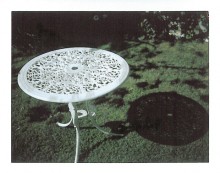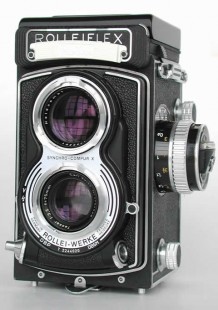This is not a Rolleiflex topic but in the last issue, I mentioned that I had bought a Polaroid 320 bellows camera for £5 and having made a simple battery holder to take CR2 lithium batteries and cleaned a few contacts, I had a good working camera. This is really about finding a cheap vintage second hand camera or accessory in unknown condition and having a go at getting it to a working condition...
Well, I came across a copy of 'The Polaroid Book' in a branch of The Works book shop. They buy up unsold stock and offer the books at 'knockdown' prices. I bought a copy and enjoyed flicking through its pages because there are many excellent images which all have a distinctive 'spontaneous' feel. Some are taken with the SX70, some with large format and some with the 'pack' films for the '100' cameras.
Spurred on to explore the medium further, I did some more research because I thought that a glass lens would improve image quality and to take portraits, I would have to get a close-up kit, which only available for the more expensive cameras with a Zeiss rangefinder. The 320 also has a separate rangefinder window next to the actual viewfinder, which is a disadvantage.
My research concluded that the best option, other than to go for the top of the range 'professional' 180, 185, 190 or 195 cameras, with manual shutter, which can cost up to £400 secondhand, was to find a model 360 with automatic exposure. Other than the professional models, it is the only model designed to take an electronic flash. The electronic flash is specific to this camera as it has a special electrical and mechanical coupling and also has a special charging unit.
These cameras were produced for the American market, having a 110v only charger.
As usual I searched Ebay and found one complete with flash, charger, close-up kit and Polaroid self timer, all in excellent condition, in a fitted Polaroid case. The purchase price was low, the carriage cost was more than the camera and then on top of that there is the import handling charge by Parcelforce plus, of course VAT on the whole lot. Not such a cheap purchase after all!
The kit was in good condition. The camera only required batteries, two this time - one for the shutter and one for the development countdown timer (just a 'gadget' and not essential to the camera's operation). Duly fitted with two batteries, the camera worked perfectly with no further attention required than a cosmetic clean. It takes good photographs and with the close-up accessory, head and shoulder portraits are well within its capability. The flash however did not work - the description had stated 'untested' so I was not overly concerned. A search on the internet produced instructions on how to dissemble the flash in order to change the NiCd batteries. They had leaked badly and most of the inside was affected.
I contacted Andrew Bell and he said he could get a new battery pack made up. I ordered one. I then started to look further into the flash; a bit of a mess. I found a repair manual on the internet - essential as it turned out in this case.
The flash circuitry is very different. Part is in the flash gun and part is in the camera body - the capacitor, battery and tube are in the flash gun and the inverter and other electronic bits are in the camera. The flash is mechanically coupled to the focus control on the camera and alters the light output by opening and closing translucent louvres in front of the flash tube. Very ingenious. There is a discharge switch which permits the capacitor to be discharged when the flash is removed from the camera or charger - the charger keeps the capacitor charged 'exercising' it so it will always give maximum output and charge quickly from the NiCd's.
The on/off switch had split apart, the discharge switch contacts were corroded; the electrical contact socket to the camera was corroded....
A complete strip-down and clean ensued; new on/off switch installed, then when 'cramming' the capacitor into the casing, the solder contact broke off the discharge switch, right in the bowels of the unit. Not a good time to be in earshot!
This switch is one component that is purpose made for that task. It is repairable - I think - but it may be easier to try to fit a miniature push button switch in its place.
Currently it is still disassembled awaiting further attention. Anyhow, I saw another complete 360 camera complete, in its original box - for less than I paid for the first one. Supposedly all working... (now just arrived and yes it is!)
I believe that if it isn't broken, don't try to fix it; if it doesn't work anyway, you can't be any worse off by trying to fix it.


